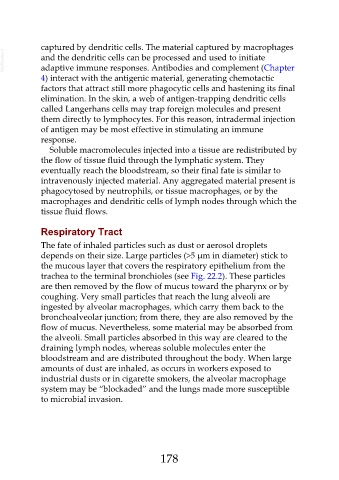Page 178 - Veterinary Immunology, 10th Edition
P. 178
captured by dendritic cells. The material captured by macrophages
VetBooks.ir and the dendritic cells can be processed and used to initiate
adaptive immune responses. Antibodies and complement (Chapter
4) interact with the antigenic material, generating chemotactic
factors that attract still more phagocytic cells and hastening its final
elimination. In the skin, a web of antigen-trapping dendritic cells
called Langerhans cells may trap foreign molecules and present
them directly to lymphocytes. For this reason, intradermal injection
of antigen may be most effective in stimulating an immune
response.
Soluble macromolecules injected into a tissue are redistributed by
the flow of tissue fluid through the lymphatic system. They
eventually reach the bloodstream, so their final fate is similar to
intravenously injected material. Any aggregated material present is
phagocytosed by neutrophils, or tissue macrophages, or by the
macrophages and dendritic cells of lymph nodes through which the
tissue fluid flows.
Respiratory Tract
The fate of inhaled particles such as dust or aerosol droplets
depends on their size. Large particles (>5 µm in diameter) stick to
the mucous layer that covers the respiratory epithelium from the
trachea to the terminal bronchioles (see Fig. 22.2). These particles
are then removed by the flow of mucus toward the pharynx or by
coughing. Very small particles that reach the lung alveoli are
ingested by alveolar macrophages, which carry them back to the
bronchoalveolar junction; from there, they are also removed by the
flow of mucus. Nevertheless, some material may be absorbed from
the alveoli. Small particles absorbed in this way are cleared to the
draining lymph nodes, whereas soluble molecules enter the
bloodstream and are distributed throughout the body. When large
amounts of dust are inhaled, as occurs in workers exposed to
industrial dusts or in cigarette smokers, the alveolar macrophage
system may be “blockaded” and the lungs made more susceptible
to microbial invasion.
178

